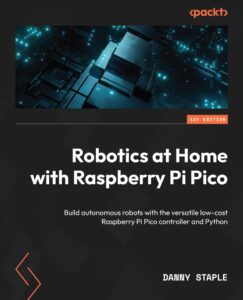Danny staple is the author of Robotics at Home with Raspberry Pi Pico, we got the chance to sit down with him and find out more about his experience of writing with Packt.
Q: What is/are your specialist tech area(s)?
Danny: My specialist areas are Robotics at home, python, IoT, software process automation and governance, and Infrastructure-as-Code.
Q: How did you become an author for Packt? Tell us about your journey. What was your motivation for writing this book?
Danny: This is my third book with Packt. I’ve written about robotics since 2000 on websites and blogs. I was interested in writing a book, and for my first book Learn Robotics Programming (first edition), Packt reached out to me at the right time. I write so that anyone can learn to make technology in their own home and time. Robotics is a great way to do so because it crosses many domains while being very exciting.
Q: What kind of research did you do, and how long did you spend researching before beginning the book?
Danny: I have been familiar with embedded python languages like MicroPython since its early versions but looked at CircuitPython due to its broad compatibility with sensor hardware. I had to get to know the Monte Carlo Localization algorithm before the book, but I wonder if it was enough when I got there! I had to get far more familiar with probability distributions and resampling than before. This was months of research.
I also spent time interfacing various sensors with the Pico and making trade-offs on their cost, utility, compatibility, availability and what the reader would learn from their use.
Q: Did you face any challenges during the writing process? How did you overcome them?
Danny: Oh yes, there were definitely challenges!
Component availability: 2022 was a challenging year for this. Although the Pico itself was available, I chose from a far more restricted set of sensors, and there were waiting times – the chip shortage made for interesting times.
Bluetooth and Wifi: I had started using an ESP-32 Wifi module but hit an issue in that module’s firmware. It wasn’t going to be easy to fix or reasonable to ask readers to update the firmware on that module. So then I pivoted to Bluetooth BLE – which meant rewriting many earlier chapters. About 2 months after that, the PicoW was released.
Monte Carlo: I thought I had done enough research into the probability systems and the other aspects of Monte Carlo Localization. However, this algorithm was far more challenging, leading to more research. In addition, I found bugs in the uLab library while testing my code and had to work around them. This definitely felt like one of the most complicated parts of any book. In hindsight, I could have spread more preparatory content for this chapter into previous chapters.
Q: What’s your take on the technologies discussed in the book? Where do you see these technologies heading in the future?
Danny: Robotics has a great future in many fields, including industrial, home and commercial robots. Hobby robotics has been undergoing a golden age, perhaps with the chip shortage a bit of an issue. Microcontroller and controller power have blossomed, as have the interesting sensors that can be used with them.
The Monte Carlo technique is not new, but understanding this approach, and the way of thinking behind it, can have applications in fields far beyond robotics, as well as being a pivotal algorithm in advanced robots.
Q. Why should readers choose this book over others already on the market? How would you differentiate your book from its competition?
Danny: At the moment, there are not many books covering robotics with the Raspberry Pi Pico, and I think this one is more ambitious in its scope than many of them.
It has a particular step by step and practical approach, leaving you with a robot platform ready for further experimentation, room for more growth and launching readers into a robotics hobby.
The combination of ambitious algorithms and Raspberry Pi Pico is unique.
Q. What are the key takeaways you want readers to come away from the book with?
Danny: The reader will have a robot platform they feel empowered to experiment with and build on. They’ll know some hardware, and have had some exposure to datasheets, so feel able to reach out for new sensors.
They’ll also have had an introduction to essential robotics algorithms, with a taste for more.
Q. What advice would you give to readers learning tech? Do you have any top tips?
Danny: Fearlessness – learning code and electronics is something you can do in your own home and your own time.
Experimentation – try building experiments for new ideas. Keep notes, and build upon what you’ve learned before.
Patience – it will probably not work the first time, but keep trying and keep learning.
Q. Do you have a blog that readers can follow??
Danny: I do, my website https://orionrobots.co.uk has my posts about my robot experiments or related code issues.
I also have a discord server at https://discord.gg/4kcSNf4Npp where readers can get in touch with me.
Q. Can you share any blogs, websites and forums to help readers gain a holistic view of the tech they are learning?
Danny: Hackaday is a maker blog with some great ideas for robot builders to play with technology.
Adafruit blogs and learn material are great for exploring sensors.
Youtube to explore lectures on robotics and maths content.
Khan Academy to learn and practice maths, physics and programming.
Brilliant.org to get understanding and practice of maths, physics and ML concepts.
Instructables is a community of things people have made with instructions to make your own – including many robotic and IoT devices. I don’t necessarily directly follow the instructions so much as raid the tutorials for ideas to try in my own robot builds.
Q. How would you describe your author journey with Packt? Would you recommend Packt to aspiring authors?
Danny: This is my third book with Packt. The structure for planning, outlining and writing is great, along with each chapter going for multiple review rounds – editorial, technical and copy editing review. This helps me get feedback on my writing before it is in print. What is great is knowing that there’s a team behind the writing, to help me with many of the aspects. I suspect I don’t make use of that team as much as I could though.
I would recommend Packt, having a team means you aren’t trying to do everything yourself, and also that you are more likely to continue writing. Getting feedback will help you improve the content and motivates you.
Q. Do you belong to any tech community groups?
Danny: I am on Twitter, and join the #makershour on Wednesday evenings (GMT).
I am also in the Adafruit and PiWars discord servers, as well as a discord server for my work at https://discord.gg/4kcSNf4Npp.
Q. What are your favorite tech journals? How do you keep yourself up to date on tech?
Danny: I use Hackaday daily, but also Twitter as there’s still a great community of makers there. I also read the blogs of vendors like Adafruit and Pimoroni. Seeing what robotics competition entries are doing also helps.
Q. How did you organize, plan, and prioritize your work and write the book?
Danny : I have a daily schedule which includes writing. There are days when I needed to put more in, and days where not as much writing happened. I break down problems into smaller items to solve. My writing involves code and practical experimentation, which comes with the positive of being able to change pace from writing, to code, to making diagrams. The space I test my robot is in our family living room, so I do have negotiate taking up that space with a test arena.
Q. What is the one writing tip that you found most crucial and would like to share with aspiring authors?
Danny: Self care. A book is a marathon, not a sprint, so ensure you look after your sleep and your health. Guard your bedtimes and beware of other obligations.
Q. Would you like to share your social handles? If so, please share.
Danny: discord: https://discord.gg/4kcSNf4Npp , twitter: https://twitter.com/orionrobots mastodon: https://fosstodon.org/@orionrobots , facebook page: facebook.com/orionrobots/ , LinkedIn: https://www.linkedin.com/in/da
You can find Danny’s book on Amazon by following this link: Please click here

Robotics at Home with Raspberry Pi Pico– Available on Amazon.com








